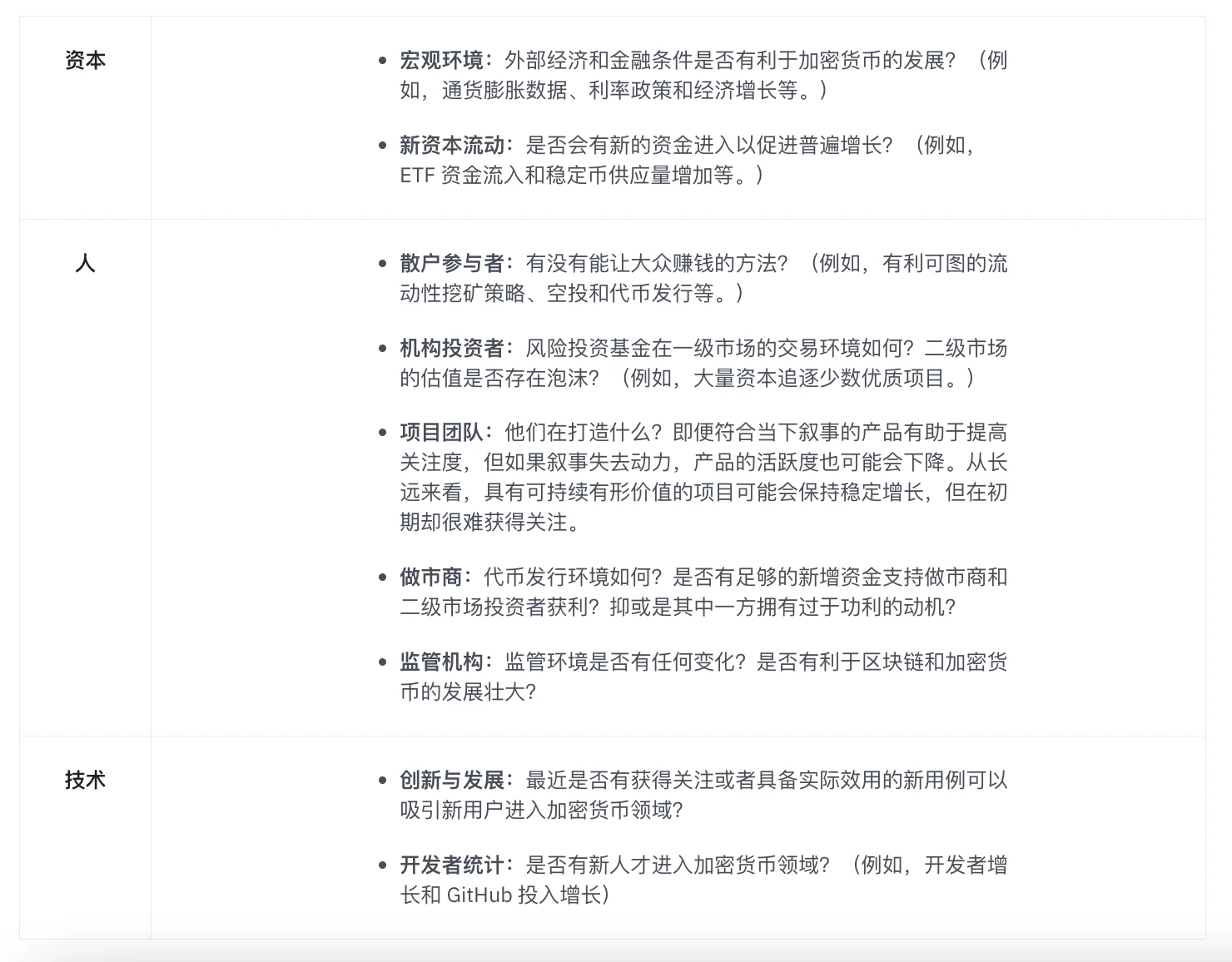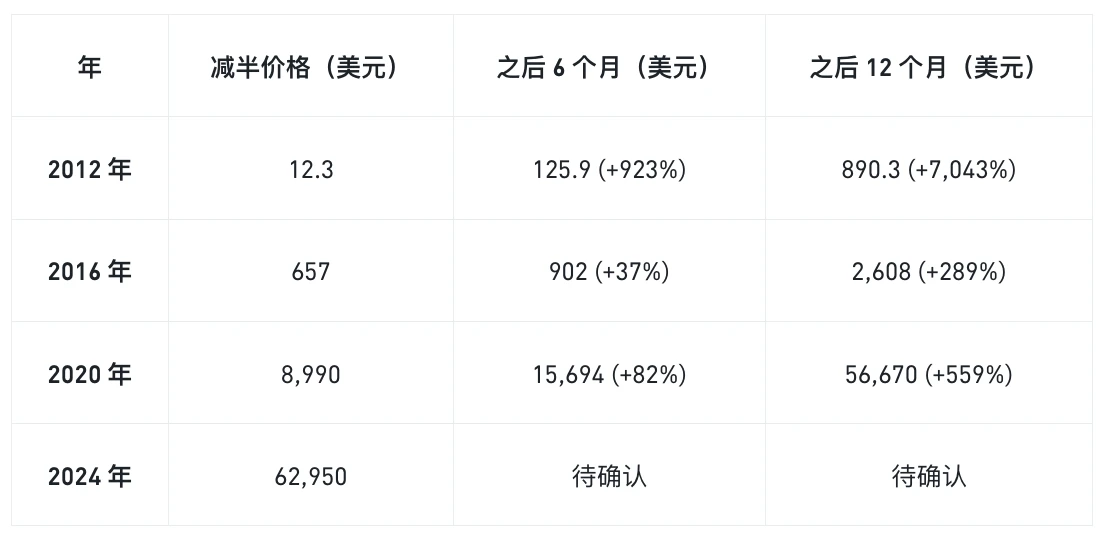Original source: Binance
Key Points
How is the cryptocurrency market doing these days? Why does it seem to lack momentum? We aim to take a closer look by examining both short-term and long-term drivers.
While most are well aware of the market events that have driven the recent sell-off, we believe that structural factors are also underlying forces influencing market dynamics.
We took a deeper look at these structural factors, launched the Binance CPT framework, and analyzed the current state of the market.
Overall, we remain optimistic about the market outlook. Several upcoming catalysts will have a positive impact on the market in the second half of this year.

Recent Market Performance
The past few months have undoubtedly been challenging ones for the cryptocurrency market. Despite a rapid rise at the beginning of the year, it seems that it has been moving sideways for some time now. The decline in June was particularly severe, with the total cryptocurrency market value falling by about 11.4% month-on-month. In recent days, the situation has eased somewhat as the market rebounded, but it is still down about 14.0% from the peak in March.
Figure 1: Cryptocurrency markets show signs of weakness after strong first quarter performance

Source: Coinmarketcap. Data as of July 18, 2024.
Factors behind the weak market
The broad decline in cryptocurrency prices coincides with several market events that have occurred in recent weeks. We are witnessing a “perfect storm” where several entities reportedly sold Bitcoin around the same time, which intensified selling pressure and sparked negative sentiment.
Mt. Gox: Began repaying creditors on July 5, distributing approximately 140,000 BTC (about $9 billion). So far, more than a third of the bitcoins have been distributed to creditors.
German Government: 50,000 BTC (about $3.2 billion) was transferred to centralized exchanges and market makers between June 19 and July 13.
U.S. Government: 3,940 BTC ($248 million) transferred to Coinbase Prime on June 26. At a national level, the U.S. government remains the largest cryptocurrency holder, holding approximately $12.8 billion in cryptocurrencies.
While the massive sell-off in Bitcoin had a negative impact on the market, there were some mitigating factors:
Fears of a mass sell-off by Mt. Gox creditors may be overblown: creditors reportedly have the choice of receiving Bitcoin or fiat. Those who choose to receive Bitcoin are likely to hold onto at least some of it rather than sell it on the market.
The German government has sold all of its Bitcoin: The German government has sold all of its Bitcoin holdings in the past month. Like ripping off a Band-Aid, the pain is only temporary and will not last.
The upcoming US election could turn the tide: Cryptocurrency has become an important issue in the election, reflecting its growing importance in the economic landscape. While the election results may not directly affect the governments Bitcoin holdings, a supportive attitude towards cryptocurrencies could lead to clearer regulations and promote the widespread use of digital assets in the United States.
Overall, the worst effects of these events may have passed, and the lasting negative impact seems limited. We also observed that market performance has rebounded over the past week.
Structural drivers cannot be ignored
While most people are well aware of the market events that led to the sell-off over the past month, we believe that structural factors are also underlying forces influencing market dynamics. This section discusses the latter.
Introduction to Binance CPT Framework
Market events tend to have an immediate impact on asset prices and grab the majority of media headlines. However, there are often multiple forces at play. Some forces may not be immediately apparent but can have a similar or even more lasting impact on the market. These structural factors take a longer time to bear fruit but form the core of the health of the cryptocurrency market.
We group these structural factors into three distinct but non-exhaustive areas and suggest some issues to consider. Capital, people, and technology form the basis of the “CPT” framework.
Figure 2: CPT framework

Analyzing the cryptocurrency market using the CPT framework
1. Capital
The inflow of new money into the cryptocurrency ecosystem has slowed down. A stagnant market without new capital flows becomes a zero-sum game: if one market participant gains, another market participant must lose. In other words, we are in what is colloquially known as a player versus player (PvP) market.
Some of the indicators we are observing include stagnant stablecoin supply, slowing project fundraising since the market peak in March, and outflows from spot Bitcoin ETFs.
Figure 3: Stablecoin market capitalization has barely grown since late April

Source: DeFi Llama. Data as of July 17, 2024.
Figure 4: Project funding amounts have been on a downward trend over the past few months

Source: Rootdata. Data as of June 30, 2024.
Figure 5: Net inflows into spot Bitcoin ETFs slowed slightly

Source: SoSoValue. Data as of July 12, 2024.
Overall, the above charts show a slowdown in the inflow of new capital into the cryptocurrency ecosystem. The velocity of capital flows has changed significantly when comparing the first and second quarters of this year. In all three charts, the first quarter shows rapid growth, while the second quarter shows a gradual slowdown. Similarly, it is probably no coincidence that the cryptocurrency market saw a large increase in the first quarter of 2024, while the second quarter generally declined.
Key points:
New capital is essential to achieving sustainable growth in the cryptocurrency market. Without new capital inflows, market participants must compete with each other to gain returns, creating a zero-sum game where some gain and some lose.
Attracting new capital requires attracting investors from all sectors of the market: primary markets (such as venture capital funds and angel investors), secondary markets (such as institutional players and retail traders), and traditional finance (such as ETFs).
While the macro environment plays an important role in driving capital flows, having a strong narrative that is easy to understand, solid fundamentals (e.g., valuation, user traction, product-market fit), and tangible use cases will help attract and maintain investor interest, ultimately leading to a healthier and stronger cryptocurrency ecosystem.
2. People
Generating sustainable returns and yields is an important motivation for many market participants, both in the cryptocurrency space and in other asset classes. Historical performance and the belief that this good run will continue are key reasons why many investors stick with traditional asset classes like stocks and bonds, through both ups and downs.
However, market participants in the cryptocurrency market have faced many challenges in recent months. In addition to the market events mentioned in the previous section, we believe that there is also selling pressure caused by the prevalence of overvalued tokens and the large number of token unlocks. In the current market environment, it is becoming increasingly difficult to earn returns. We look at this situation from the perspective of several market participants:
Retail investors: As the overall market and altcoins have been hit hard, most new projects launched so far this year have been on a downward trend.
Institutional investors (primary market): Most venture capital funds may still have paper gains, but trading activity has decreased. Tokens that are about to vest are at lower valuations, thus reducing profitability.
Project Teams: Since part of the team’s compensation is often paid in the project’s native token, lower valuations will result in lower overall team compensation. Teams that do not conduct a Token Generation Event (TGE) may remain private longer while waiting for the market to improve. Overall, lower token valuations weaken financial strength and may discourage talent from building cryptocurrencies.
Market Makers (MM): Market makers play an important role in providing liquidity for newly listed tokens. In a consolidation or bear market, newly launched tokens may not rise significantly due to low trading volumes, and the profitability of market makers faces more challenges.
Regulators: Clear regulations lay the foundation for large-scale applications. Circle announced that it has become the worlds first stablecoin issuer that complies with the EUs Crypto-Asset Market Regulation Act (MiCA) regulatory framework, which is undoubtedly a positive development. As a popular regulated stablecoin, USDC will play an important role in promoting trust and adoption of cryptocurrency assets.
Over time, as portfolio values stagnate or decline, market participants exit the market or reduce trading activity. We have seen this phenomenon occur over the past few months, with trading volumes declining since the peak in March.
Figure 6: After reaching its peak price in March, trading volume has declined

Source: The Block. Data as of July 17, 2024.
As mentioned earlier, we believe that the difficult market environment stems from structural challenges. In Binance’s previous report , “The Prevalence of Low Circulating Supply, High FDV Tokens and Analysis of the Causes” , we highlighted the problems associated with the prevalence of low circulating supply and high valuation tokens. The general consensus is that after the Token Generation Event (TGE), this market structure will not bring sustainable upside to the overall market. This is particularly evident when we compare these new tokens with tokens launched in the past few years: The ratio of market capitalization (MC) to fully diluted market capitalization (FDV) of tokens launched in 2024 is the lowest in recent years, indicating that a large number of tokens will be unlocked in the future.
Figure 7: Tokens launched in 2024 have the lowest MC/FDV, and the gap is quite large

Source: Twitter (@thedefivillain). Data as of June 3, 2024.
Notably, it is estimated that approximately $155 billion worth of tokens will be unlocked between 2024 and 2030. This influx of tokens into the market will create selling pressure if there is no corresponding increase in buy-side demand and capital flows.
Key points:
The prevalence of tokens with high valuations and low initial circulating supply poses a structural challenge to long-term sustainable returns.
Following Binance’s last report , we have observed an increase in awareness and discussion about this phenomenon, prompting more investors to research token economics on their own to avoid any risks that could lead to losses.
In order to further create a healthy and sustainable market environment, Binance is also committed to supporting high-quality projects with small and medium market capitalizations.
3. Technology
The past year has seen significant technological advances in the blockchain and cryptocurrency space, some of which will have positive long-term impacts (such as scaling solutions) while others address immediate needs (such as improved user experience). These initiatives are critical to making it easier to attract more users to the cryptocurrency space.
User-centric developments such as features that make on-chain transactions smoother (e.g., Solana blockchain links and intent-based architecture), tools that simplify processes (e.g., account abstraction and trading bots), and DApps that can appeal to a wide user base (some decentralized social DApps have achieved some success) are some examples of simplifying the user experience and lowering the barrier to entry for non-crypto natives.
Granted, we still have a long way to go in attracting the next billion users. Currently, capital is still flowing significantly into infrastructure projects, which are critical to the ecosystem and form the most fundamental cornerstone. However, many infrastructure projects tend to be developer-facing platforms (e.g., blockchains), while DApps are the consumer-facing front end for user interaction and attention. The surge in the number of Layer 1 and Layer 2 has led to a fragmentation of liquidity and may not help in attracting attention.
Figure 8: Infrastructure projects receive unusually large amounts of funding from private markets

Source: The Block. Data as of July 17, 2024.
Key points:
Technological advancement and innovation play an important role in attracting a wider and more diverse audience to the cryptocurrency ecosystem. By providing real use cases and real value, we can attract individuals who are looking for more than just financial gain.
While infrastructure projects are important, they receive more attention and funding than normal. Investing some of these resources in developing useful, diverse, and innovative DApps could help expand the reach of the cryptocurrency ecosystem and attract more users.
Upcoming Catalysts
Despite the structural challenges, we remain optimistic about the outlook for the second half of the year. Several upcoming catalysts are likely to propel the industry forward.
Spot Ethereum ETF approved: Multiple media outlets citing sources disclosed that this could happen around July 23. New capital inflows will increase demand for ETH, and as rising tides lift all boats, this will drive a general recovery in the market. Note that the impact may not be immediate (see what we saw after the BTC ETF was approved in January).
Macro Environment: With inflation showing signs of tapering off (the latest CPI data fell for the third consecutive month and was below expectations), traders are currently pricing in a rate cut in September. Lower interest rates reduce the cost of money, which typically stimulates a number of different markets and could be a potential positive for both the stock and cryptocurrency markets.
US Presidential Election and Bitcoin Conference: Polymarket currently predicts that Donald Trump has a 70% chance of winning the upcoming presidential election in November. The Trump campaign accepted cryptocurrency donations in May and has become increasingly positive about the future of digital assets. Trump also announced crypto-friendly Senator JD Vance as his vice presidential pick. The senator has disclosed that his BTC holdings are between $100,000 and $250,000 and has made positive statements about blockchain technology. Trump will be in the spotlight when he speaks at a Bitcoin conference in Nashville on July 27.
Impact of Bitcoin Halving: Bitcoin prices typically move higher within 6 to 12 months after the halving. While past performance is no guarantee of future results, this timing roughly coincides with the Federal Reserves (Fed) September meeting and the U.S. presidential election.
Figure 9: Historically, Bitcoin prices have risen within 6 to 12 months after a halving

Source: Coinmarketcap and Binance Research. Data as of July 17, 2024.
Conclusion
Market cycles always go up and down. Pullbacks are common and can even help restore healthy levels when markets become overly volatile.
At this point, it may be helpful to take a broader view, look to the future, and re-examine your strategy. Are you holding cryptocurrencies in your portfolio for the long term? Perhaps you believe that cryptocurrencies have the potential to fill gaps in traditional systems, introduce new ways of operating, or become an important asset in your portfolio. If so, you can take advantage of market pullbacks to increase your portfolio. If you are more risk-averse, evaluate your investment horizon and liquidity needs. Sometimes holding can be a good strategy.










